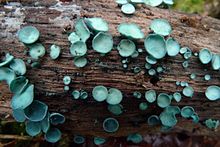Helotiales is an order of the class Leotiomycetes within the division Ascomycota.[1] The taxonomy within Helotiales has been debated. It has expanded significantly as genomic techniques for taxonomical identification have become more commonly used. As of February 2020[update], the order is estimated to contain 30 accepted families, 519 genera, and 6266 species.[2]
| Helotiales | |
|---|---|

| |
| Chlorociboria (Chlorociboriaceae) | |
| Scientific classification | |
| Domain: | Eukaryota |
| Kingdom: | Fungi |
| Division: | Ascomycota |
| Class: | Leotiomycetes |
| Subclass: | Leotiomycetidae |
| Order: | Helotiales Nannf. ex Korf & Lizon (2000) |
| Families | |
|
See text | |
Helotiales is the largest order of non-stromatic discomycetes that usually, but not always, have brightly coloured apothecia. Many members of the family have obviously cup-shaped ascomata with little or no stipes. They are usually found fruiting on coarse or large wood debris as well as on other organic matter. Part of these discomycetes are limited to a specific host range, this goes as far as to not just being limited to one particular plant, additionally some species need a particular part of that plant.[3]
Description
edit- Helotiales is distinguished by its disc or cup-shaped apothecia.
- Its asci are only slightly thickened in contrast to other Leotiomycetes
- Most Helotiales species live as saprobes on soil humus, dead logs, manure and other organic matter.
- The order includes most fungi that engage in ericoid mycorrhiza, including Rhizoscyphus ericae, Meliniomyces species and Cairneyella variabilis.
- The order contains some of the most severe plant pathogens such as Monilinia fructicola (brown rot on stone fruits), Sclerotinia sclerotiorum (lettuce drop and other diseases), D. rosae (black spot of roses), Sclerotium cepivorum (soft rot of onions) and Botrytis cinerea.
Families
edit- Amicodiscaceae
- Arachnopezizaceae
- Bryoglossaceae
- Cenangiaceae
- Chlorociboriaceae[3][4][5]
- Chlorospleniaceae
- Chrysodiscaceae
- Dermateaceae
- Discinellaceae
- Drepanopezizaceae
- Gelatinodiscaceae
- Godroniaceae
- Hamatocanthoscyphaceae
- Helotiaceae
- Heterosphaeriaceae
- Hyaloscyphaceae
- Hydrocinaceae
- Lachnaceae
- Loramycetaceae
- Mitrulaceae
- Mollisiaceae
- Neolauriomycetaceae
- Pleuroascaceae
- Ploettnerulaceae
- Rutstroemiaceae
- Sclerotiniaceae[6]
- Solenopeziaceae
- Tympanidaceae
- Vibrisseaceae[7]
Disputed or previously included families
edit- Amorphothecaceae - Kirk (2008) assigned to Helotiales, but reclassified under order Erysiphales.[8][9]
- Ascocorticiaceae - reclassified under order Medeolariales[10]
- Hemiphacidiaceae - Merged with Cenangiaceae in the 2010s.[11]
- Phacidiaceae (also known as Bulgariaceae) - reclassified under order Phacidiales[12]
- Vandijckellaceae - identified by Crous et al. (2017), not widely accepted.[13]
-
Green Elfcup or Green Wood Cup Chlorociboria aeruginascens, family: Chlorociboriaceae
(photo: Holger Krisp) -
Ascocoryne, family: Helotiaceae
-
Mollisia benesuada, family: Dermateaceae
-
Bisporella citrina, family: Helotiaceae
-
Arachnopeziza aurata, family: Hyaloscyphaceae
-
Brown oak disk cup Rutstroemia firma, family: Rutstroemiaceae
(photo: Holger Krisp) -
The necrotrophic fungus Botrytis conidiophores, Magnification X16, family: Sclerotinaceae
See also
editReferences
edit- ^ Lumbsch TH, Huhndorf SM (December 2007). "Outline of Ascomycota – 2007". Myconet. 13. Chicago, USA: The Field Museum, Department of Botany: 1–58. Archived from the original on 2009-03-18.
- ^ Kirk, Paul (2020). "Species Fungorum for CoL+ | COL". www.catalogueoflife.org. doi:10.48580/dfp3-4hj. Retrieved 2022-03-30.
- ^ a b "Helotiales: The non-stromatic Cup Funghi". Mycologywebpages New Brunswick Museum. Retrieved 29 November 2021.
- ^ Kuo M (2004). "Chlorociboria aeruginascens & C. aeruginosa". Retrieved 29 August 2009.
- ^ Johnston PR, Park D, Smith ME, Mujic AB, May TW (2021). "Brahmaculus gen. nov. (Leotiomycetes, Chlorociboriaceae)". MycoKeys (80): 19–43. doi:10.3897/mycokeys.80.64435. PMC 8121775. PMID 34025144.
- ^ Wang Z, Binder M, Hibbett DS (September 2005). "Life history and systematics of the aquatic discomycete Mitrula (Helotiales, Ascomycota) based on cultural, morphological, and molecular studies". American Journal of Botany. 92 (9): 1565–1574. doi:10.3732/ajb.92.9.1565. PMID 21646174.
- ^ Korf RP (1990). "Discomycete systematics today: a look at some unanswered questions in a group of unitunicate ascomycetes". Mycosystema. 3: 19–27.
- ^ Kirk PM, Cannon PF, Minter DW, Stalpers JA (2008). Dictionary of the Fungi (10th ed.). Wallingford, UK: CABI. p. 310. ISBN 978-0-85199-826-8.
- ^ "Amorphothecaceae". www.gbif.org. Retrieved 2022-03-30.
- ^ Quandt CA, Haelewaters D (2021-01-01), "Phylogenetic Advances in Leotiomycetes, an Understudied Clade of Taxonomically and Ecologically Diverse Fungi", in Zaragoza Ó, Casadevall A (eds.), Encyclopedia of Mycology, Oxford: Elsevier, pp. 284–294, doi:10.1016/B978-0-12-819990-9.00052-4, ISBN 978-0-323-85180-0, S2CID 235849988
- ^ Pärtel, Kadri; Baral, Hans-Otto; Tamm, Heidi; Poldmaa, Kadri (2016). "Evidence for the polyphyly of Encoelia and Encoelioideae with reconsideration of respective families in Leotiomycetes". Fungal Diversity. 82 (1): 183–219. doi:10.1007/s13225-016-0370-0. S2CID 256067853.
- ^ Crous PW, Quaedvlieg W, Hansen K, Hawksworth DL, Groenewald JZ (December 2014). "Phacidium and Ceuthospora (Phacidiaceae) are congeneric: taxonomic and nomenclatural implications". IMA Fungus. 5 (2): 173–193. doi:10.5598/imafungus.2014.05.02.02. PMC 4329319. PMID 25734027.
- ^ Crous PW, Wingfield MJ, Burgess TI, Carnegie AJ, Hardy GE, Smith D, et al. (December 2017). "Fungal Planet description sheets: 625-715". Persoonia. 39 (1): 270–467. doi:10.3767/persoonia.2017.39.11. PMC 5832955. PMID 29503478.
- ^ "Vibrissea truncorum (Alb. & Schwein.) Fr. (335788)". Mushroom Observer. Retrieved 29 November 2021.
External links
edit- Media related to Helotiaceae at Wikimedia Commons